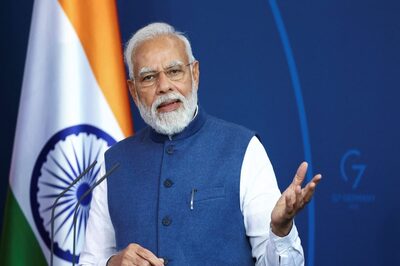
views
New Delhi: If the Indian government provides budgetary support for integrating variable renewable energy (VRE), India will see a rapid increase in greener forms of energy, especially solar, for electricity generation, said a new report by the Council on Energy, environment and Water. The New Delhi based think tank launched the report — 'Sustainable Development, Uncertainties, and India’s Climate Policy' — on April 30, to examine what kind of uncertainties in India’s push for renewable energy could affect the Nationally Determined Commitments (NDCs) it made for the 2015 Paris Agreement on combating climate change.
The report noted that there is an urgent need for a India specific study up to 2050 on estimating the cost of integrating VRE. However, with the available data and the modeling frameworks, the report says that India is on the path to achieve, "even exceed", its NDCs — India's stated target is that non-fossil fuels will comprise 40 percent of India’s electricity generation by 2030.
According to the report, non-fossil fuels will already make up 48 percent of the electricity generated by 2030 and 59 percent in 2050, even if the producers and/or generators of VRE pay for the integration costs. This could go up to 58 percent in 2030 and 74 percent in 2050 if this integration cost is not levied on producers and is borne through budgetary support.
If there is budgetary support to absorb the cost of setting up solar energy infrastructure, the report calculates, the total subsidy outlay in 2015 prices would be Rs. 215,000 crore, between 2015 and 2030, and Rs. 3,750,000 between 2030 and 2050. The actual subsidy that power distribution companies received was Rs. 36,758 crore in 2013-14, Rs.45,584 crore in 2014-15, and Rs. 55,283 crore in 2015-16.
The report calls for coal to bear the cost of this subsidy. Between 2010-11 and 2016-17 India collected a coal cess of Rs. 56,600 crore, and the amount collected in the next 15 years will provide significant financial support to subsidise renewable energy integration cost.
Greener electrification is a necessity for India. With rising incomes in urban and rural India, the per capita household consumption of electricity will rise four times in rural households and five times in urban, by 2050 relative to 2015, found the report.
India needs to be better prepared for such a transition. Solar energy demands large tracts of land, the availability of which could be an "impediment". The report terms land acquisition in India- a challenge. It cannot be done without keeping the welfare and rehabilitation of local populations in view. Additionally, India's population is expected to rise by 20 percent by 2050, straining land resources.
The shift from coal to VRE will also mean loss of jobs for those working in the former sector. These workers cannot automatically be absorbed into jobs opened up by VRE as “it is not necessary that the states that lose coal-based jobs and revenue will gain from the solar boom”, says the report. Not to mention, the nature of the job and the required skill set are different. These can only be mitigated if Indian policy makers strategise for this looming change in status-quo.
India and other countries made their NDCs according to the principles of historic responsibility and common but differentiated responsibility. The principles, based on equity, charge countries with a history of emissions — mostly the western countries with a past long steeped in industrialisation — to carry the larger burden of addressing climate change, as compared to India and the rest of the global south.
The report, however, says that India could bear a disproportionate responsibility to cut emissions for the world, but at the cost of this equity. Instead of an equity-based analysis, the report undertook a techno-economic analysis that implies that “emissions should be mitigated where it is cheapest to mitigate”. Based on these considerations, if India is to align itself with the aim of the Paris Agreement — to halt the rise in global temperatures to 2 degree Celsius increase limit — its share of electricity generation from non fossil fuel energy will have to be 98 percent by 2050.




















Comments
0 comment